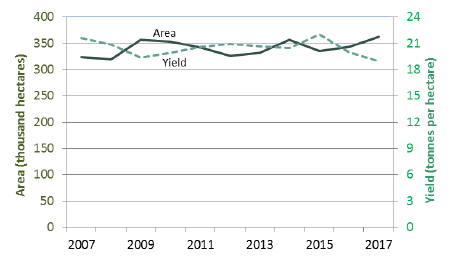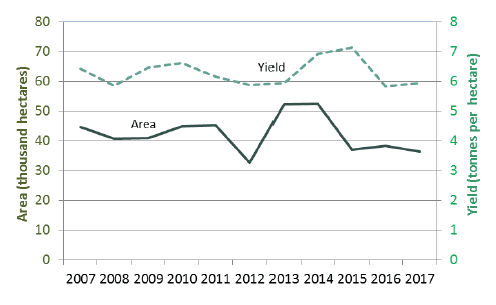Scottish agricultural survey: December 2017
Annual agricultural survey based on data from larger agricultural holdings together with estimates for smaller farms.
4. Hay and silage
Chart 3 shows the production of silage/haylage, hay and arable silage between 2007 and 2017. These results also include estimates for hay and grass silage/haylage production on minor agricultural holdings.
Year-on-year comparisons between 2016 and 2017 show:
- The estimated grass silage/haylage production remained similar at 6.9million tonnes (up 0.3 per cent). The tonnage is 1.4 per cent lower than the ten year average of 7.0 million tonnes.
- A decrease in arable silage production of 72,600 tonnes (22 per cent) to 256,000 tonnes. The tonnage is 21 per cent lower than the ten year average of 326,000 tonnes.
- A decrease in the production of hay of 8,000 tonnes (three per cent) to 217,000 tonnes. The tonnage is 18 per cent lower than the ten year average of 265,000 tonnes.
4.1 Production
In terms of total tonnage, grass silage/haylage accounted for 94 per cent of production in 2017, with arable silage three per cent and hay three per cent. However, this does not take into account dry matter and nutrient content, which is higher per tonne in hay and arable silage.
Longer term trends show that the production of grass silage/haylage has remained fairly steady over the past ten years. Arable silage production decreased between 2006 and 2012, but has fluctuated around 325,000 tonnes since, until this year. The hay figures show very strong weather effects, with a very low figure in 2012, and tonnages almost as low in the last two years.
Chart 3: Production of hay, silage/haylage and arable silage [1] , 2007 to 2017

4.2 Silage
The production of silage is dependent on both the areas of grass cut and the yields per hectare. Chart 4 shows trends for areas and yields of grass cut since 2007. In 2017 the total area cut increased by 18,900 hectares (six per cent) to 362,000 hectares (shown on the left-hand axis). A reduction in the yield (down from 20 to 19 tonnes per hectare, shown on the right-hand axis) led to a similar level of production of grass silage/haylage (up 24,000 tonnes, 0.3 per cent) at 6.9 million tonnes).
For silage and haylage production, several cuts of grass can be taken from the same area in a single year. The yields reported here correspond to total production, which incorporates all cuts of grass taken from the corresponding area. In 2017, the total area of grass reported on the December Survey for the production of hay, silage and haylage was 398,000 hectares. This represents 30 per cent of the 1.33 million hectares of grass area reported on all holdings in the 2017 June Census.
Chart 4: Area of grass cut for silage/haylage and yields 2007 to 2017

4.3 Hay
Chart 5 illustrates how the area of grass cut for hay has varied. After two years in 2013 and 2014 with relatively high areas grown, the area has been just under 40,000 hectares.
Hay yields have fluctuated between six and seven tonnes per hectare over the past ten years. 2017 saw a relatively low yield of 6.0 tonnes per hectare, similar to 2016.
Chart 5: Area of grass cut for hay and yields 2007 to 2017

4.4 Arable Silage
Separate information on the area of arable silage is not collected on the December Survey, so it is not possible to produce a corresponding analysis of areas and yields. Production of arable silage will be determined by a range of factors. These include the areas of arable crops, which are collected on the June Census, but also decisions by farmers on how much of this crop to use for arable silage. This in turn may be determined by the quality of these arable crops, with poorer crops generally being used for animal feed, including arable silage.
4.5 Grass sown
Data for the area of grass sown are only available for larger holdings (generally at least one hectare), and results exclude smaller holdings which, in June 2016, accounted for approximately four per cent of the total area of grassland (temporary and permanent grass).
The area of grass sown on larger holdings in the last ten years has ranged between 41,000 and 60,000 hectares. In 2017 there was a drop from 2016 of 6,400 hectares (12 per cent) to 48,100 hectares. The total area sown at 1 st December 2017 equates to three per cent of the total grass area on larger holdings at 1 st June 2017 (1.83 million hectares). Of the total sown, 16,700 hectares was under-sown to cereal or other crops (grass and cereals grown together allowing grass to establish ready for autumn grazing whilst still giving a useful yield of grain) and 31,400 hectares was directly sown or reseeded.
Contact
Email: Nora.Mielke@gov.scot
There is a problem
Thanks for your feedback